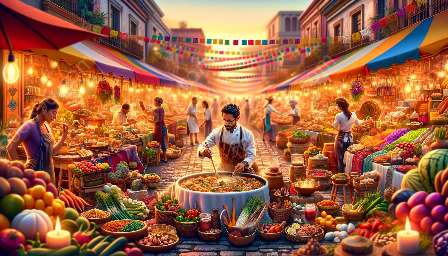Chilean cuisine is a reflection of the country's rich cultural heritage, blending indigenous traditions, European influences, and local ingredients to create a unique and diverse culinary tapestry. The history of Chilean cuisine is intricately connected to the country's cultural evolution, and understanding its roots provides a deeper appreciation for the flavors and dishes that define this vibrant culinary tradition.
The Cultural Tapestry of Chilean Cuisine
Chilean cuisine is a fusion of indigenous Mapuche traditions and Spanish colonial influences, with a sprinkle of other European and global culinary elements. The indigenous Mapuche people, known for their agricultural expertise, contributed essential staples such as corn, potatoes, quinoa, and beans to the Chilean culinary repertoire. These ingredients formed the foundation of many traditional Chilean dishes and continue to play a vital role in the country's food culture.
Spanish colonization in the 16th century introduced a new wave of flavors and cooking techniques to Chile. The Spanish brought with them ingredients like wheat, rice, and livestock, along with culinary methods such as frying and baking. These influences further enriched Chilean cuisine, leading to the creation of iconic dishes that reflect the fusion of indigenous and colonial elements.
The Role of Geography and Climate
The geographical diversity of Chile, which spans from the driest desert in the world to the southern tip of Patagonia, has profoundly shaped the country's culinary landscape. Each region boasts its own distinct ingredients and culinary traditions, influenced by the unique climate and terrain. Coastal areas offer an abundance of fresh seafood, while the Central Valley provides fertile grounds for cultivating fruits, vegetables, and grains. In the south, the traditional cuisine showcases game meats, freshwater fish, and foraged ingredients, adding to the multifaceted nature of Chilean gastronomy.
Chilean Cuisine in the Context of Latin American Culinary History
Within the larger context of Latin American cuisine, Chilean gastronomy stands out for its blend of native flavors and international influences. Similar to other Latin American countries, Chile's culinary heritage reflects the complex interplay of pre-Columbian traditions, colonial legacies, and global connections. The fusion of indigenous, European, African, and Asian culinary elements has contributed to the vibrancy and diversity of Latin American cuisine as a whole.
Chilean cuisine shares similarities with its Latin American counterparts in its use of staple ingredients such as corn, beans, and potatoes, which were foundational to pre-Columbian diets. Additionally, the Spanish influence on cooking techniques and certain ingredients echoes throughout the broader Latin American culinary landscape, showcasing the interconnectedness of the region's food cultures.
Recent Culinary Trends and Innovations
While honoring its rich culinary history, Chilean cuisine continues to evolve through modern interpretations and innovative approaches. The country's chefs and food enthusiasts are reimagining traditional dishes, incorporating contemporary culinary techniques, and experimenting with novel flavor combinations. This dynamic blend of heritage and creativity has resulted in an exciting culinary scene that celebrates the diversity and adaptability of Chilean gastronomy.
Conclusion
Chilean cuisine is a captivating mosaic of flavors, traditions, and historical influences that have shaped the country's culinary identity. Its cultural history intertwines indigenous heritage, Spanish colonial legacies, and the diverse geography of the region, culminating in a vibrant and diverse food culture that continues to inspire and delight. Understanding the rich tapestry of Chilean cuisine not only provides insight into the country's history and traditions but also offers a tantalizing journey for food enthusiasts seeking to explore the depths of Latin American culinary heritage.

